"Hedgehog" on the road: measuring network quality
This is a measurement machine, it’s a mobile lab, and it’s a “hedgehog” in the jargon. Almost ordinary car, which is quite difficult to see in the stream. From the outside, there is nothing particularly conspicuous.

Hedgehog is called because of such a feature:
')

These are antennas of special cellular terminals located in the measuring complex. At the disposal of the Radio Measurement and Quality Control Department of the Beeline Technical Directorate of the Moscow Region, there are 4 such machines, and they travel around the city every day to take measurements on the network.
Each mobile laboratory has one or two measuring complexes that operate simultaneously and solve various tasks, such as measuring signal strength, network availability and quality of established connections, testing data services, monitoring system parameters, comparing network parameters of different operators, etc. .
Let's look inside. Inside there is a pair of laptops on special stands that are connected to incomprehensible blocks. On laptops - software that tracks work with phones. In fact, it is a measuring complex designed for testing voice services. It consists of six blocks, each of which is a computer that collects and processes data from each of the six mobile phones with a special software inside.
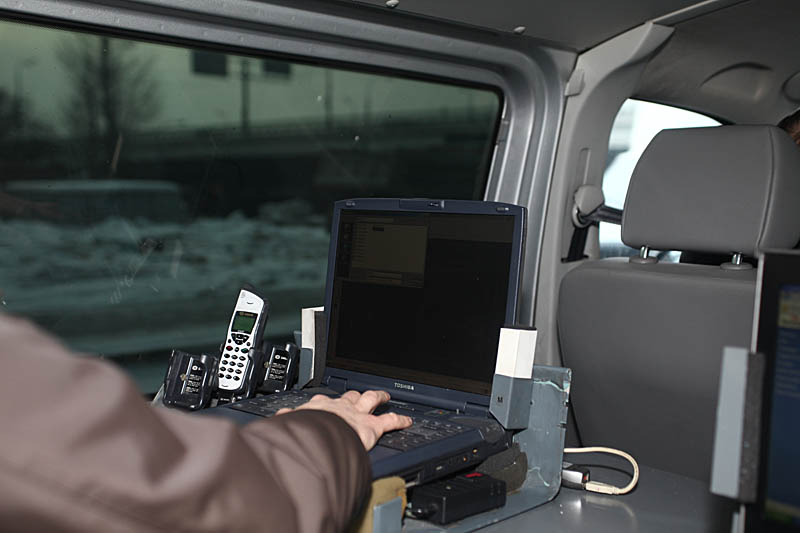
Object of study for today - Lyubertsy. The process begins immediately as the car leaves the garage of the Moscow office. Engineer Aleksey, who monitors the equipment, turns on the complexes and launches the measuring software. Statistics in the city itself is collected at least four hours.
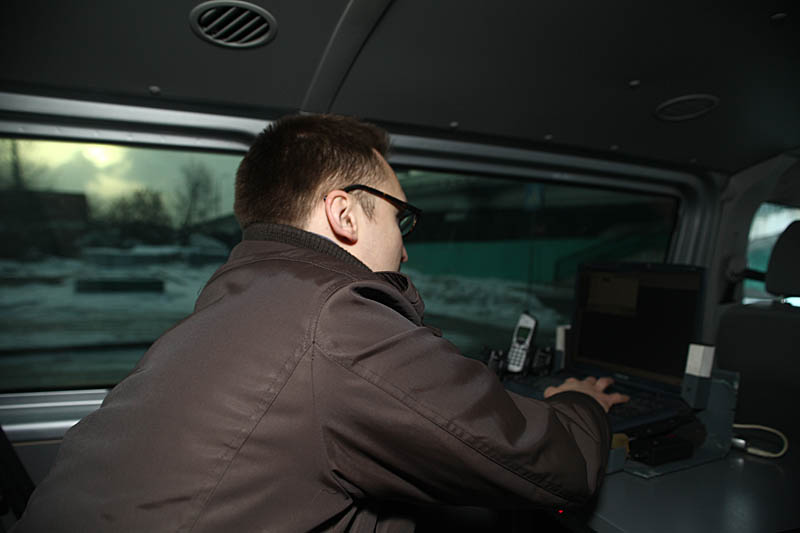
“Hedgehog” is going on a trip either to collect statistics (this is a regular task for planning, maintaining and developing the network), or for testing the operation of new sites, or by subscriber calls about poor communication quality. Now there is a collection of statistics on the cities of the Moscow region for the Network Planning Department ... Statistics are written and further analyzed.
All received information is recorded in real time and displayed on a monitor of a laptop connected to the complex. Using this laptop, you can control the network parameters, start / stop the radio measurement program, make changes to the measurement program, etc. That is, data on coverage (signal level) and voice quality are written at each point of the route. The duration of calls and all necessary pauses are regulated from the software.
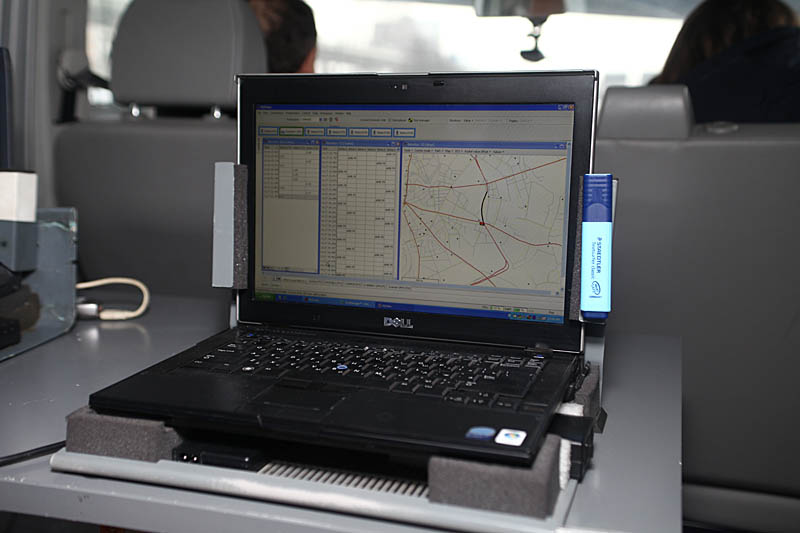
The complex has a built-in GPS receiver, the data from which is also recorded in the log files of radio measurements. The whole complex works on external antennas located on the roof of the car. These are the usual whip omnidirectional antennas.
Interestingly, voice quality and coverage are not always related. It happens that with “all sticks” subscribers complain about poor sound transmission: in this case, the “hedgehog” leaves and starts taking measurements. The reasons for this phenomenon are interference between the BS and subscribers, various kinds of interference. If it is necessary to examine a specific area with interference, a spectrum analyzer is used. The most common causes of interference are either illegally installed repeaters, military installations, plus various kinds of radio receiving points.

The laptop is connected with 6 phones. They work in pairs, the first phone rings on the second, third on the fourth, fifth on the sixth. The complex also includes a scanning receiver, or an abbreviated scanner. It scans the frequency bands of all three operators, in all systems (2G / 3G). It is the scanner that measures the coating, i.e. signal parameters, the main one of which is the signal level, and base station identifiers. Three pairs of phones have SIM cards of three operators. Each phone in a pair calls to the second, plays the reference sound file, the second phone in the pair records it, compares it with the standard in memory, then plays the sound file to the first one, the latter records it and compares it with the standard. This allows you to assess the quality of voice transmission.
When measuring 2G coverage, the key parameter is Rx Level - the signal level of the base station. In the talk mode, the Rx Quality parameter is also taken into account - signal quality in conventional units from 1 to 7, where 7 is the worst quality and 1 is the best. When measuring the 3G network, the RSCP parameters are the signal level, and Ec / No is the signal-to-noise ratio. On the above described complex, the quality of voice transmission is also measured. It is measured in arbitrary units of PESQ from 1 to 5. But the value is non-linear, i.e. PESQ values of up to 1.5 are considered to be very poor quality; from 1.5 to 2.1 - poor quality; from 2.1 to 2.7 - satisfactory; from 2.7 to 3.5 - good; above 3.5 is excellent.
Here is the unit in the rack under the laptops:
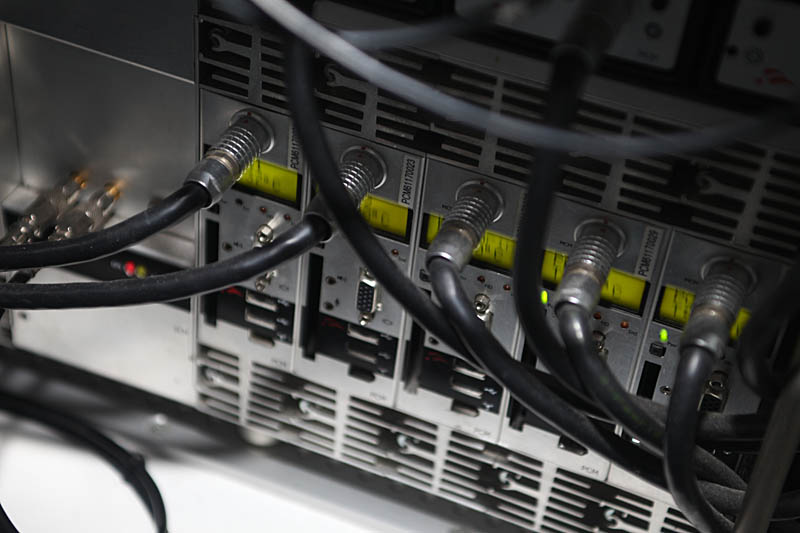
Here, in the upper cases - phones with special software. Each has a connector for an external antenna - and each cable goes to the roof of the car. The complex is supplied by the vendor already assembled, and the phones are one of its “spare parts”.

And this is the second old 2G-complex, it is used as a backup.
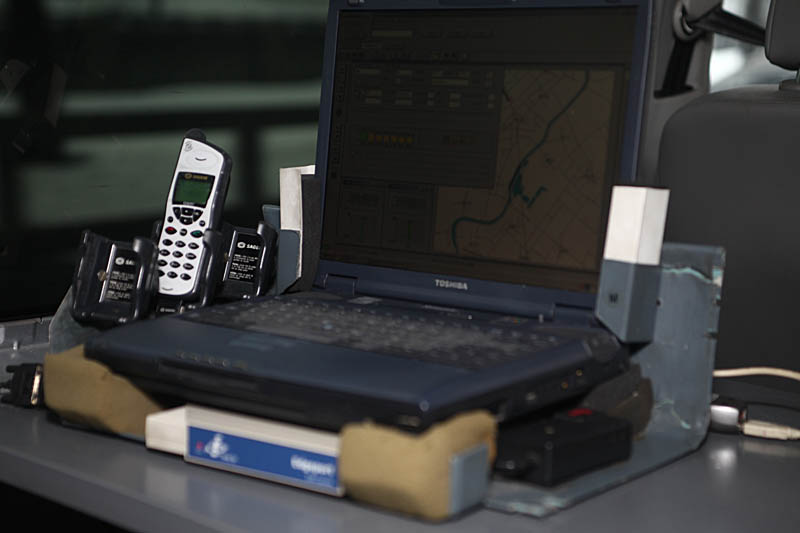
At the disposal of the Radio Measurement and Quality Control Division, there are mobile terminals with the ability to measure network parameters, voice quality and record results, which allows solving customer problems on the spot (in the office, subway, warehouses, etc.). They are not included in the set of mobile laboratories, but are used separately at the place of demand.
The available instrumentation also allows testing of 4G networks.
Mobile laboratories “monitor” coverage on the streets of Moscow and the region on a daily basis, thereby regularly supplementing and updating the Beeline network coverage map. The responsibilities of each researcher include:
Data is researched and analyzed using special software. We study not only the measured parameters of the radio signal and the quality of voice transmission, but also the number of broken calls, nedozvonov, as well as their causes. The processed data is transmitted to various departments of VimpelCom, such as the network optimization department, the planning service, the frequency planning department, or the marketing service. Only in 2012 in the Moscow region the number of 2G BS was increased by 15%, BS 3G - by 50%, the network capacity was increased by more than 2 times. At present, 75% of base stations in the region are connected to high-speed channels, 60% of BS are running HSPA +, and the number of BSs supporting UMTS900 is 5 times larger. 4 new switches with a capacity of hardware for 3.5 million subscribers were installed, the controller equipment of the 3G network was updated, which made it possible to increase the capacity of controllers by more than 2.5 times. In addition, the data transfer speed increased by 25%, and the percentage of successful calls in 3G / 2G networks is more than 98%. In general, the process of building, debugging, setting up and operating the network can be described as follows: planning> building> radio measurements> debugging-tuning> radio measurements> operating> planning. The process is cyclic and one without the other is simply impossible.
Yes, you probably wonder if it is not dangerous to be in a car with so many antennas. Not dangerous: firstly, all antennas are on the roof and oriented so that the directivity pattern with its petals goes sideways and upwards, secondly, the antennas themselves are far from human, thirdly, the metal roof shields well. The effect is the same as being in the same room with a person talking on the phone, that is, the radiation density is ten times less than just when talking on the phone without a headset.
Everything, Alexey went with us today:

And the driver Nikolay:
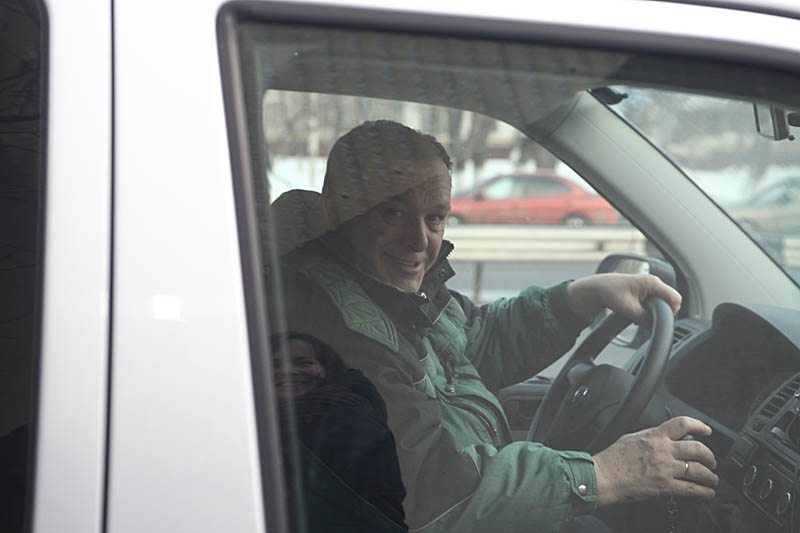
If you have questions - write, Alexey will see them and answer after departure.

Hedgehog is called because of such a feature:
')

These are antennas of special cellular terminals located in the measuring complex. At the disposal of the Radio Measurement and Quality Control Department of the Beeline Technical Directorate of the Moscow Region, there are 4 such machines, and they travel around the city every day to take measurements on the network.
Each mobile laboratory has one or two measuring complexes that operate simultaneously and solve various tasks, such as measuring signal strength, network availability and quality of established connections, testing data services, monitoring system parameters, comparing network parameters of different operators, etc. .
Let's look inside. Inside there is a pair of laptops on special stands that are connected to incomprehensible blocks. On laptops - software that tracks work with phones. In fact, it is a measuring complex designed for testing voice services. It consists of six blocks, each of which is a computer that collects and processes data from each of the six mobile phones with a special software inside.

Object of study for today - Lyubertsy. The process begins immediately as the car leaves the garage of the Moscow office. Engineer Aleksey, who monitors the equipment, turns on the complexes and launches the measuring software. Statistics in the city itself is collected at least four hours.

“Hedgehog” is going on a trip either to collect statistics (this is a regular task for planning, maintaining and developing the network), or for testing the operation of new sites, or by subscriber calls about poor communication quality. Now there is a collection of statistics on the cities of the Moscow region for the Network Planning Department ... Statistics are written and further analyzed.
All received information is recorded in real time and displayed on a monitor of a laptop connected to the complex. Using this laptop, you can control the network parameters, start / stop the radio measurement program, make changes to the measurement program, etc. That is, data on coverage (signal level) and voice quality are written at each point of the route. The duration of calls and all necessary pauses are regulated from the software.

The complex has a built-in GPS receiver, the data from which is also recorded in the log files of radio measurements. The whole complex works on external antennas located on the roof of the car. These are the usual whip omnidirectional antennas.
Interestingly, voice quality and coverage are not always related. It happens that with “all sticks” subscribers complain about poor sound transmission: in this case, the “hedgehog” leaves and starts taking measurements. The reasons for this phenomenon are interference between the BS and subscribers, various kinds of interference. If it is necessary to examine a specific area with interference, a spectrum analyzer is used. The most common causes of interference are either illegally installed repeaters, military installations, plus various kinds of radio receiving points.

The laptop is connected with 6 phones. They work in pairs, the first phone rings on the second, third on the fourth, fifth on the sixth. The complex also includes a scanning receiver, or an abbreviated scanner. It scans the frequency bands of all three operators, in all systems (2G / 3G). It is the scanner that measures the coating, i.e. signal parameters, the main one of which is the signal level, and base station identifiers. Three pairs of phones have SIM cards of three operators. Each phone in a pair calls to the second, plays the reference sound file, the second phone in the pair records it, compares it with the standard in memory, then plays the sound file to the first one, the latter records it and compares it with the standard. This allows you to assess the quality of voice transmission.
When measuring 2G coverage, the key parameter is Rx Level - the signal level of the base station. In the talk mode, the Rx Quality parameter is also taken into account - signal quality in conventional units from 1 to 7, where 7 is the worst quality and 1 is the best. When measuring the 3G network, the RSCP parameters are the signal level, and Ec / No is the signal-to-noise ratio. On the above described complex, the quality of voice transmission is also measured. It is measured in arbitrary units of PESQ from 1 to 5. But the value is non-linear, i.e. PESQ values of up to 1.5 are considered to be very poor quality; from 1.5 to 2.1 - poor quality; from 2.1 to 2.7 - satisfactory; from 2.7 to 3.5 - good; above 3.5 is excellent.
Here is the unit in the rack under the laptops:

Here, in the upper cases - phones with special software. Each has a connector for an external antenna - and each cable goes to the roof of the car. The complex is supplied by the vendor already assembled, and the phones are one of its “spare parts”.

And this is the second old 2G-complex, it is used as a backup.

At the disposal of the Radio Measurement and Quality Control Division, there are mobile terminals with the ability to measure network parameters, voice quality and record results, which allows solving customer problems on the spot (in the office, subway, warehouses, etc.). They are not included in the set of mobile laboratories, but are used separately at the place of demand.
The available instrumentation also allows testing of 4G networks.
Mobile laboratories “monitor” coverage on the streets of Moscow and the region on a daily basis, thereby regularly supplementing and updating the Beeline network coverage map. The responsibilities of each researcher include:
- Monitoring the performance of base stations after the introduction of new or upgraded old ones.
- Measurement of radio coverage for network design and optimization.
- Testing the network area after the introduction of new equipment, or new settings on the network, upgrade system software.
- Monitoring network availability and measurement of voice quality, comparing them with other operators.
- Testing of data transmission services based on GPRS / EDGE / UMTS and their comparison with other operators.
- Optimization of system parameters.
- Search for sources of electromagnetic interference.
- Departures on complaints of subscribers.
- Search and solve problems on the network.
- Measuring support of work on the network, conducted by various departments of the technical directorate.
Data is researched and analyzed using special software. We study not only the measured parameters of the radio signal and the quality of voice transmission, but also the number of broken calls, nedozvonov, as well as their causes. The processed data is transmitted to various departments of VimpelCom, such as the network optimization department, the planning service, the frequency planning department, or the marketing service. Only in 2012 in the Moscow region the number of 2G BS was increased by 15%, BS 3G - by 50%, the network capacity was increased by more than 2 times. At present, 75% of base stations in the region are connected to high-speed channels, 60% of BS are running HSPA +, and the number of BSs supporting UMTS900 is 5 times larger. 4 new switches with a capacity of hardware for 3.5 million subscribers were installed, the controller equipment of the 3G network was updated, which made it possible to increase the capacity of controllers by more than 2.5 times. In addition, the data transfer speed increased by 25%, and the percentage of successful calls in 3G / 2G networks is more than 98%. In general, the process of building, debugging, setting up and operating the network can be described as follows: planning> building> radio measurements> debugging-tuning> radio measurements> operating> planning. The process is cyclic and one without the other is simply impossible.
Yes, you probably wonder if it is not dangerous to be in a car with so many antennas. Not dangerous: firstly, all antennas are on the roof and oriented so that the directivity pattern with its petals goes sideways and upwards, secondly, the antennas themselves are far from human, thirdly, the metal roof shields well. The effect is the same as being in the same room with a person talking on the phone, that is, the radiation density is ten times less than just when talking on the phone without a headset.
Everything, Alexey went with us today:

And the driver Nikolay:

If you have questions - write, Alexey will see them and answer after departure.
Source: https://habr.com/ru/post/172871/
All Articles